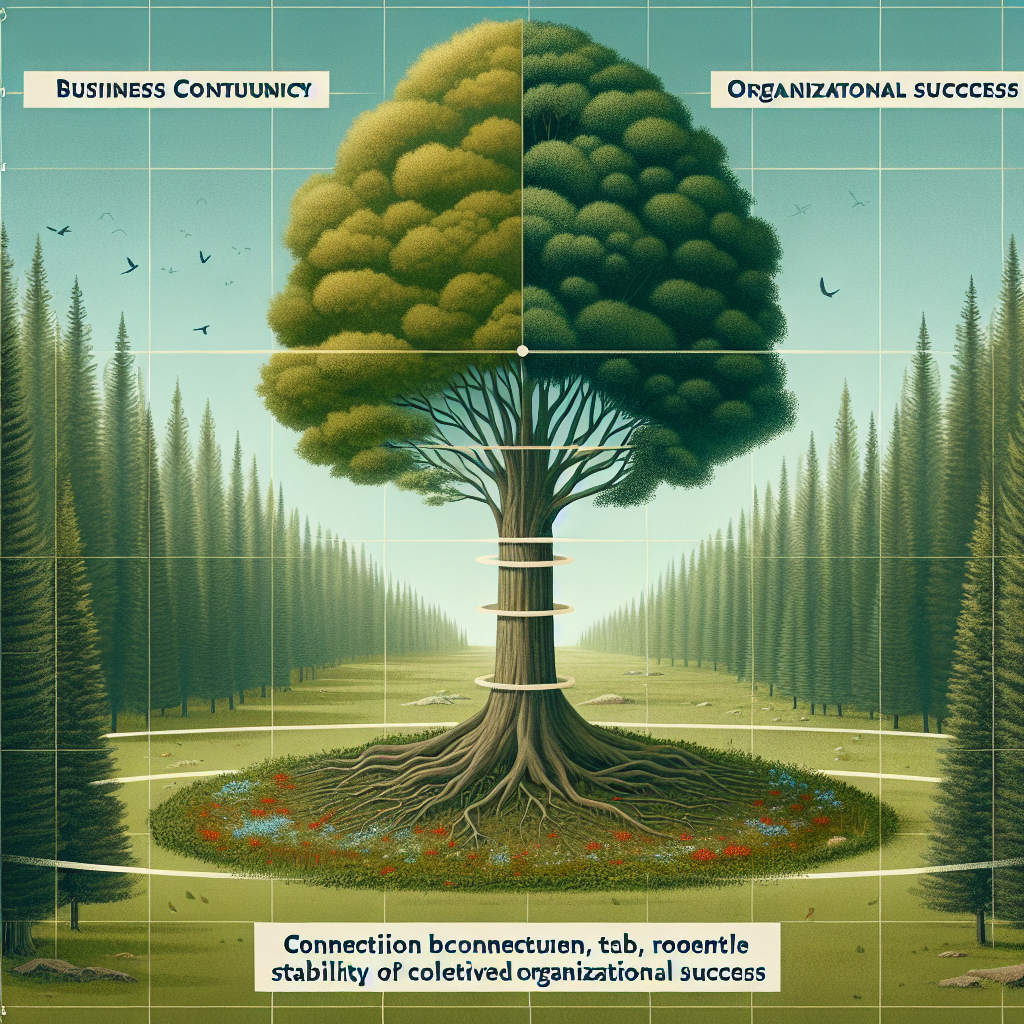Your cart is currently empty!
Tag: Business Continuity

The Future of Business Continuity: Trends and Technologies to Watch
Business continuity is a critical aspect of any organization’s strategy for ensuring that operations can continue in the face of unexpected disruptions. As technology evolves and new challenges emerge, the future of business continuity is constantly evolving. Here are some key trends and technologies to watch in the coming years.1. Cloud-based solutions: The cloud has revolutionized the way businesses operate, offering increased flexibility, scalability, and cost-effectiveness. Cloud-based business continuity solutions are becoming increasingly popular, allowing organizations to store data and applications off-site and access them in the event of a disaster.
2. Artificial intelligence and machine learning: AI and machine learning technologies are being used to enhance business continuity planning and response. These technologies can analyze vast amounts of data to predict potential disruptions and automate response processes, helping organizations to minimize downtime and recover more quickly.
3. Internet of Things (IoT): The IoT is connecting devices and sensors to the internet, providing real-time data on everything from equipment performance to environmental conditions. This data can be used to improve business continuity planning by identifying vulnerabilities and predicting potential disruptions before they occur.
4. Cybersecurity: Cyber attacks are a major threat to business continuity, with hackers constantly seeking to disrupt operations and steal sensitive data. As cyber threats evolve, organizations must invest in robust cybersecurity measures to protect their systems and data.
5. Remote work solutions: The COVID-19 pandemic has accelerated the shift towards remote work, highlighting the importance of ensuring that employees can work effectively from anywhere. Business continuity plans must now include provisions for remote work, including secure access to company systems and data.
6. Blockchain technology: Blockchain technology offers a secure and transparent way to store and share data, making it ideal for ensuring the integrity of critical information during a disruption. By leveraging blockchain technology, organizations can enhance the security and resilience of their business continuity plans.
7. Data analytics: Data analytics can provide valuable insights into business operations, helping organizations to identify trends and patterns that may impact continuity. By analyzing data from various sources, organizations can make more informed decisions and proactively address potential disruptions.
In conclusion, the future of business continuity is evolving rapidly, driven by advancements in technology and changes in the business landscape. By staying abreast of these trends and technologies, organizations can better prepare for and respond to disruptions, ensuring that their operations remain resilient and sustainable in the face of uncertainty.

Case Studies in Business Continuity: Lessons Learned from Real-World Disasters
Business continuity planning is essential for organizations to ensure that they are able to recover from disruptions and continue operations in the event of a disaster. Case studies of real-world disasters can provide valuable insights into the importance of effective business continuity planning and the lessons that can be learned from these incidents.One such example is the case of Hurricane Katrina, which struck the Gulf Coast of the United States in 2005. The storm caused widespread destruction and resulted in the displacement of thousands of people. Many businesses in the affected areas were forced to shut down temporarily or permanently due to the damage caused by the hurricane.
One of the key lessons learned from Hurricane Katrina is the importance of having a comprehensive business continuity plan in place. Organizations that had robust plans in place were able to recover more quickly and resume operations sooner than those that did not. This highlights the importance of conducting risk assessments, developing contingency plans, and regularly testing and updating these plans to ensure that they are effective in the event of a disaster.
Another example of a real-world disaster that can provide valuable insights into business continuity planning is the 2011 earthquake and tsunami in Japan. The disaster caused widespread damage to infrastructure and disrupted supply chains, leading to significant challenges for businesses operating in the affected areas.
One of the lessons learned from the Japan earthquake is the importance of having a resilient supply chain. Organizations that had diversified supply chains and contingency plans in place were better able to mitigate the impact of the disaster and continue operations. This underscores the importance of conducting risk assessments, identifying critical suppliers, and developing alternative sourcing strategies to ensure business continuity in the event of a disruption.
In conclusion, case studies of real-world disasters can provide valuable insights into the importance of effective business continuity planning and the lessons that can be learned from these incidents. By studying these cases and implementing best practices in business continuity planning, organizations can better prepare for and recover from disasters, ensuring the resilience and sustainability of their operations in the face of adversity.

Ensuring Business Continuity: Best Practices for Small Businesses
In today’s fast-paced and ever-changing business environment, it is crucial for small businesses to have a plan in place to ensure business continuity in the face of unexpected disruptions. Whether it be a natural disaster, cyber-attack, or pandemic, having a solid plan in place can help small businesses navigate through challenging times and minimize the impact on their operations.Here are some best practices for small businesses to ensure business continuity:
1. Develop a Business Continuity Plan (BCP): Every small business should have a BCP in place that outlines how the business will continue to operate in the event of a disruption. This plan should identify key business processes, critical assets, and potential risks, as well as outline specific steps to take to mitigate those risks and ensure business continuity.
2. Identify key stakeholders: It is important for small businesses to identify key stakeholders, both internal and external, who will be involved in the business continuity process. This includes employees, customers, suppliers, and other partners who play a critical role in the business’s operations.
3. Implement a robust IT infrastructure: In today’s digital age, having a secure and reliable IT infrastructure is essential for small businesses to ensure business continuity. This includes regularly backing up data, implementing cybersecurity measures, and having a plan in place to restore systems and data in the event of a cyber-attack or other IT disruption.
4. Cross-train employees: Cross-training employees on key business processes and tasks can help ensure that the business can continue to operate smoothly even if key personnel are unavailable due to a disruption. This can help minimize downtime and ensure that critical tasks are still being completed.
5. Communicate with stakeholders: Effective communication is key during a business disruption. Small businesses should have a communication plan in place to keep employees, customers, suppliers, and other stakeholders informed about the situation and any changes to operations. This can help maintain trust and confidence in the business during challenging times.
6. Test and update the BCP regularly: It is important for small businesses to regularly test and update their BCP to ensure that it remains relevant and effective. This can help identify any gaps or weaknesses in the plan and allow the business to make necessary adjustments to improve its business continuity strategy.
By following these best practices, small businesses can better prepare for and navigate through unexpected disruptions, ensuring that they can continue to operate and thrive in the face of adversity. Implementing a solid business continuity plan can help small businesses protect their operations, employees, and reputation, and ultimately increase their chances of long-term success.

The Role of Technology in Enhancing Business Continuity and Disaster Recovery Plans
In today’s fast-paced and highly interconnected world, businesses are increasingly reliant on technology to operate efficiently and effectively. However, with this reliance comes the risk of technology failures, cyber attacks, and natural disasters that can disrupt operations and put the business at risk. In order to mitigate these risks and ensure business continuity, companies need to have robust disaster recovery plans in place that leverage technology to enhance their resilience.One of the key roles of technology in enhancing business continuity and disaster recovery plans is its ability to automate and streamline processes. Automation tools can be used to back up data, monitor systems for potential issues, and quickly respond to and recover from disruptions. This not only reduces the likelihood of human error but also speeds up the recovery process, minimizing downtime and ensuring that critical business functions can continue without interruption.
Cloud computing is another technology that plays a crucial role in enhancing business continuity and disaster recovery plans. By storing data and applications in the cloud, businesses can access them from anywhere, at any time, even if their physical infrastructure is compromised. This flexibility and redundancy can be a lifesaver in the event of a disaster, allowing employees to continue working remotely and keeping the business running smoothly.
In addition to automation and cloud computing, technology also enables businesses to test and refine their disaster recovery plans more effectively. Through simulations and drills, companies can identify weaknesses in their plans and make necessary adjustments to improve their readiness for potential disruptions. This proactive approach can help businesses minimize the impact of disasters and recover more quickly when they occur.
Furthermore, technology can also be used to enhance communication and collaboration during a crisis. With tools like instant messaging, video conferencing, and collaboration platforms, employees can stay connected and work together seamlessly, even when they are geographically dispersed. This can help facilitate a coordinated response to a disaster and ensure that critical information is shared quickly and effectively.
In conclusion, technology plays a vital role in enhancing business continuity and disaster recovery plans by automating processes, leveraging cloud computing, facilitating testing and refinement, and enabling communication and collaboration. By leveraging these technologies effectively, businesses can improve their resilience in the face of disruptions and ensure that they can continue to operate successfully, even in the face of unexpected challenges.

How to Develop a Robust Business Continuity Strategy for Your Organization
In today’s fast-paced and unpredictable business environment, it is more important than ever for organizations to have a robust business continuity strategy in place. A well-developed strategy can help organizations respond effectively to disruptions, minimize downtime, and protect their reputation and bottom line. Here are some key steps to develop a strong business continuity strategy for your organization:1. Identify potential risks: The first step in developing a business continuity strategy is to identify potential risks that could impact your organization. These risks could include natural disasters, cyber attacks, supply chain disruptions, and other unforeseen events. Conduct a thorough risk assessment to identify and prioritize these risks based on their likelihood and potential impact on your business.
2. Develop a business impact analysis: Once you have identified potential risks, conduct a business impact analysis to assess the potential consequences of these risks on your organization. This analysis will help you understand the critical functions and processes that need to be prioritized in your business continuity plan.
3. Define recovery objectives: Based on the results of your risk assessment and business impact analysis, define clear recovery objectives for your organization. These objectives should outline the timeframes within which critical functions and processes need to be restored in the event of a disruption.
4. Develop a business continuity plan: With your risk assessment, business impact analysis, and recovery objectives in hand, develop a comprehensive business continuity plan that outlines the strategies and procedures to be followed in the event of a disruption. This plan should include detailed instructions for responding to different types of disruptions, as well as communication protocols, roles and responsibilities, and a clear chain of command.
5. Test and update your plan regularly: Once you have developed your business continuity plan, it is crucial to test it regularly to ensure its effectiveness. Conduct tabletop exercises and simulations to identify any gaps or weaknesses in your plan and make necessary updates. It is also important to review and update your plan regularly to account for changes in your organization’s operations, technology, and external environment.
6. Train your employees: A strong business continuity strategy is only effective if employees are aware of their roles and responsibilities in the event of a disruption. Provide training and awareness programs to ensure that all employees understand the business continuity plan and know how to respond effectively in an emergency.
7. Establish partnerships and relationships: In developing your business continuity strategy, it is important to establish partnerships and relationships with key stakeholders, such as suppliers, customers, and government agencies. These partnerships can help facilitate a coordinated response in the event of a disruption and ensure a seamless recovery process.
By following these steps and developing a robust business continuity strategy, your organization can be better prepared to respond effectively to disruptions and protect its operations, reputation, and bottom line. Investing the time and resources in developing a strong business continuity plan is essential for ensuring the long-term resilience and success of your organization.

Business Continuity in Action: Real-Life Examples of Successful Crisis Management
In today’s fast-paced and unpredictable business environment, the ability to effectively manage crises and ensure business continuity is essential for the success of any organization. The COVID-19 pandemic has highlighted the importance of having robust crisis management strategies in place to navigate through challenging times and emerge stronger on the other side.There are several real-life examples of successful crisis management that demonstrate the power of proactive planning and quick decision-making in times of crisis. These examples showcase how organizations can effectively respond to unexpected disruptions and maintain business operations despite significant challenges.
One such example is the response of global technology giant Apple to the COVID-19 pandemic. When the virus began spreading rapidly across the globe, Apple quickly implemented measures to protect its employees and ensure business continuity. The company shifted to remote work for its employees, implemented strict safety protocols in its manufacturing facilities, and ramped up its online sales and customer support channels to meet the changing needs of consumers.
Another example of successful crisis management is the response of retail giant Walmart to natural disasters such as hurricanes and wildfires. Walmart has a comprehensive crisis management plan in place that includes pre-positioning emergency supplies, coordinating with local authorities, and activating its emergency response team to ensure the safety of its employees and customers. By taking proactive measures and working closely with community partners, Walmart has been able to quickly reopen stores and provide essential goods and services to affected areas.
In the financial services sector, the response of American Express to the 2008 financial crisis serves as a prime example of successful crisis management. Despite facing significant challenges during the economic downturn, American Express focused on strengthening its core business operations, diversifying its revenue streams, and implementing cost-cutting measures to weather the storm. The company emerged from the crisis stronger and more resilient, thanks to its strategic planning and decisive actions in the face of adversity.
These real-life examples of successful crisis management highlight the importance of having a comprehensive business continuity plan in place to protect against unforeseen disruptions. By proactively identifying potential risks, developing contingency plans, and implementing effective communication strategies, organizations can navigate through crises with confidence and emerge stronger on the other side.
In conclusion, business continuity is not just a theoretical concept – it is a critical aspect of successful crisis management that can make or break an organization in times of uncertainty. By learning from real-life examples of successful crisis management, businesses can better prepare for future challenges and ensure their long-term sustainability and success.

Mitigating Risks and Ensuring Sustainability: The Benefits of Business Continuity
In today’s fast-paced and ever-changing business environment, it is crucial for companies to have a solid business continuity plan in place to mitigate risks and ensure sustainability. Business continuity refers to the ability of an organization to continue operating and delivering products or services in the face of disruptions, such as natural disasters, cyber attacks, or supply chain disruptions. By having a well-thought-out business continuity plan, companies can minimize the impact of these disruptions and maintain business operations.There are numerous benefits to implementing a business continuity plan. One of the most significant advantages is the ability to mitigate risks. By identifying potential threats and vulnerabilities, companies can proactively develop strategies to prevent or minimize the impact of disruptions. This can help protect the company’s reputation, financial stability, and relationships with customers and suppliers. In addition, having a business continuity plan in place can help companies comply with regulatory requirements and industry standards, demonstrating their commitment to risk management and sustainability.
Another key benefit of business continuity is ensuring sustainability. By taking steps to protect their operations and assets, companies can ensure their long-term viability and success. This is especially important for small and medium-sized businesses that may not have the resources to recover quickly from a major disruption. By investing in business continuity planning, companies can build resilience and adaptability into their operations, enabling them to weather any storm and thrive in the face of challenges.
In addition to mitigating risks and ensuring sustainability, business continuity planning can also have a positive impact on employee morale and productivity. Knowing that their company has a plan in place to protect them and their jobs can give employees peace of mind and confidence in the organization’s leadership. This can lead to increased loyalty, engagement, and commitment, ultimately driving better performance and results.
Overall, implementing a business continuity plan is a wise investment for companies of all sizes and industries. By proactively identifying and addressing potential risks, companies can protect their operations, assets, and reputation, ensuring their long-term sustainability and success. In today’s unpredictable business environment, having a solid business continuity plan in place is essential for companies looking to thrive and grow in the face of challenges.

The Link Between Business Continuity and Organizational Success
Business continuity planning is crucial for ensuring that an organization can continue to operate smoothly in the face of unexpected disruptions. From natural disasters to cyberattacks, there are a myriad of threats that can jeopardize a company’s ability to function effectively. By having a comprehensive business continuity plan in place, businesses can minimize the impact of these disruptions and maintain operations during times of crisis.One of the key benefits of business continuity planning is that it helps organizations to identify potential risks and vulnerabilities before they occur. By conducting a thorough risk assessment, companies can pinpoint areas of weakness and develop strategies to mitigate these risks. This proactive approach can help businesses to prevent disruptions from occurring in the first place, or at least minimize their impact when they do occur.
In addition, business continuity planning can help organizations to maintain the trust and confidence of their stakeholders. Whether it’s customers, investors, or employees, stakeholders rely on businesses to deliver products and services consistently and reliably. By demonstrating that they have a plan in place to address potential disruptions, businesses can reassure stakeholders that they are prepared for any eventuality and can continue to meet their needs even in challenging circumstances.
Furthermore, having a robust business continuity plan in place can give organizations a competitive advantage. In today’s fast-paced and interconnected world, disruptions can have far-reaching consequences that can impact a company’s reputation, market share, and bottom line. By being able to maintain operations during times of crisis, businesses can differentiate themselves from their competitors and position themselves as reliable and resilient partners for their customers and suppliers.
Ultimately, the link between business continuity and organizational success is clear. By investing in comprehensive business continuity planning, companies can enhance their resilience, protect their reputation, and maintain their competitive edge. In an uncertain and volatile business environment, having a solid plan in place to address disruptions is essential for ensuring long-term success and sustainability.

From Preparation to Recovery: A Comprehensive Guide to Business Continuity
In today’s fast-paced and unpredictable business environment, it is essential for organizations to have a comprehensive plan in place for business continuity. From natural disasters to cyber attacks, there are many potential threats that can disrupt operations and put a company’s future at risk. That is why it is crucial for businesses to have a solid strategy in place to ensure they can quickly recover and resume normal operations in the event of a crisis.The first step in creating a business continuity plan is preparation. This involves identifying potential risks and threats that could impact the business, as well as assessing the potential impact of these risks on the organization. It is important to involve key stakeholders in this process, including senior management, IT staff, and other relevant departments.
Once the risks have been identified, the next step is to develop a plan for how the organization will respond to these threats. This plan should outline the steps that need to be taken to ensure the safety of employees, protect critical assets, and minimize the impact on operations. It is important to prioritize these steps based on the severity of the threat and the potential impact on the business.
In addition to having a plan in place for responding to emergencies, it is also important for organizations to have a plan for recovery. This involves outlining the steps that need to be taken to resume normal operations after a crisis has occurred. This may include restoring IT systems, repairing damaged facilities, and communicating with customers and stakeholders.
It is also important for organizations to regularly test and update their business continuity plans to ensure they are effective and up-to-date. This may involve conducting regular drills and exercises to simulate different scenarios and identify any gaps in the plan. It is also important to review the plan regularly to ensure it reflects any changes in the business environment or new threats that may have emerged.
Overall, creating a comprehensive business continuity plan is essential for organizations to ensure they can quickly recover and resume normal operations in the event of a crisis. By taking the time to prepare and plan for potential risks, organizations can minimize the impact of emergencies and protect their future success.

The Cost of Ignoring Business Continuity: Why Every Organization Needs a Plan
In today’s fast-paced and unpredictable business environment, it is more important than ever for organizations to have a solid business continuity plan in place. Ignoring the need for such a plan can have costly consequences that could potentially cripple a company.Business continuity planning involves identifying potential risks and developing strategies to mitigate them in order to ensure the continued operation of the organization in the event of a disruption. This disruption could be anything from a natural disaster, cyber attack, or even a global pandemic like COVID-19.
One of the biggest costs of ignoring business continuity planning is the potential loss of revenue. If a company is unable to operate due to a disruption, it could lose out on valuable sales and revenue, leading to financial losses that could be difficult to recover from. In fact, studies have shown that businesses that do not have a business continuity plan in place are more likely to go out of business within a year of a major disruption.
Another cost of ignoring business continuity planning is damage to the organization’s reputation. In today’s digital age, news of a company’s failure to plan for a disruption can spread quickly, damaging its reputation and eroding customer trust. This can have long-lasting effects on the company’s bottom line and make it difficult to attract new customers in the future.
Additionally, ignoring business continuity planning can lead to regulatory fines and legal consequences. Many industries have strict regulations in place that require companies to have a business continuity plan in place to protect sensitive data and ensure the safety of their employees. Ignoring these regulations can result in hefty fines and legal action that can further damage the organization’s finances and reputation.
In conclusion, the cost of ignoring business continuity planning far outweighs the investment in developing a solid plan. By taking the time to identify risks, develop strategies to mitigate them, and regularly test and update the plan, organizations can ensure their continued operation in the face of any disruption. It is crucial for every organization, no matter the size or industry, to have a business continuity plan in place to protect its employees, customers, and bottom line.
